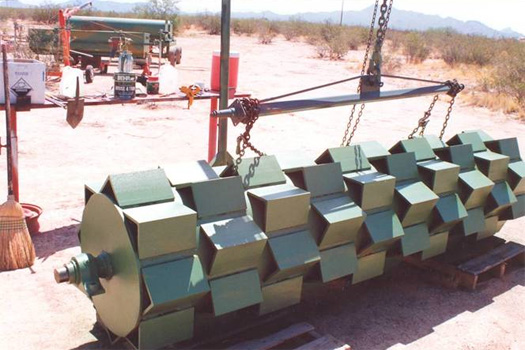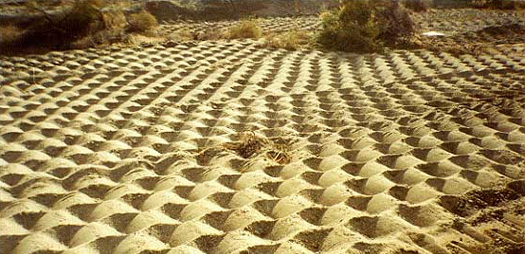
[The Dixon Land Imprinter, described by the Out of Water project.]
This is probably a bit late to be truly timely, but there are a pair of interdisciplinary-but-architecturally-oriented conferences this weekend (1 and 2 April) hosted by the Universities of Pennsylvania and Toronto, which may be of interest to mammoth readers who are in or can get to those locations this weekend. Both conferences — “In the Terrain of Water” at Penn, and “Out of Water” at Toronto — are themed around water, with “In the Terrain of Water” beginning with the abundance of water and “Out of Water” starting with its absence, which makes them a nice pair, even if it is physically impossible to be at both conferences. (I’ll be at neither, unfortunately.)


[Top: a Dixon imprinter; bottom: imprinted land, ready to concentrate rainwater and nurture seedlings; via the Imprinting Foundation.]
Briefly, quoted descriptions of the two conferences, beginning with “In the Terrain of Water”:
Water is everywhere before is somewhere. It is rain before it is rivers, it soaks before it flows, it spreads before it gathers, it blurs before it clarifies. Water at these moments in the hydrological cycle is not easy to picture in maps or contain within lines. It is however to these waters that people are increasingly turning to find innovative solutions to the myriad water-related crises that catalyze politics, dynamics, and fears. Is it not time to re-invent our relationship with water — see water as not within, adjoining, serving, or threatening settlement, but the ground of settlement? Could this be the basis of a new vocabulary of place, history, and ecology? And can the field of design, by virtue of its ability to articulate and re-visualize, lead in the constructing this new vocabulary?
The symposium will be taking place on April 1-2, 2011 at the University of Pennsylvania. There is also an exhibition associated with the symposium, running from March 28- April 4, with a gallery talk taking place on March 31. This will feature drawings by Ian L. McHarg, Louis I. Kahn, Lawrence Halprin, as well as work current Penn faculty, including James Corner, Dilip da Cunha, and Jenny Sabin.
and “Out of Water”:
This conference will offer a forum for water experts in the fields of design, engineering, natural and social sciences to identify not only specific disciplinary methodologies, but also areas of applied and theoretical intersections with respect to water scarcity in arid regions. These investigations will be discussed in context of varying technical and sociopolitical dimensions of water scarcity.
Twenty-two established and emergent designers, scholars and scientists will be brought together to evaluate currently-implemented solution with regard to their efficiency and geographic relevance.
The disciplines represented in this conference include environmental law and water policy, public health, agronomy, hydrology, geography, building science, business strategies, civil engineering, landscape architecture, architecture and urban design.
There are numerous factors that cause water scarcity worldwide, including climatological, environmental and anthropogenic factors such as over-consumption, failing infrastructure, unsustainable agricultural practices and contamination. The challenges posed by water scarcity are currently most acute in arid and underdeveloped regions. Research in these regions should prove to be relevant to those interested in the role that water will come to play in shaping our built environments and our political and economic arenas. In fact, water issues will likely come to play an increasingly important role in instigating academic and professional collaborations and fostering meaningful political dialogues.
Registration (there’s a cost to both conferences) and more details are at the conference websites, linked above.
[Places is running a series of articles timed to coordinate with the conference, such as Kristi Dykema Cheramie’s “The Scale of Nature”, on the Mississippi River Basin Model, and a slideshow of photographs of waterbodies in urbanizing Mexico by Alejandro Cartagena, “Lost Rivers”.]


I wonder if the discussion taking on both sides of water-urbanism was planned?
love the land imprinter. didn’t know this existed. A year or two ago I was thinking an old knobby tractor tire could be weighted and do the same thing done for large scale community gardens or sapling plantings, but this would be far more effective. nice find.